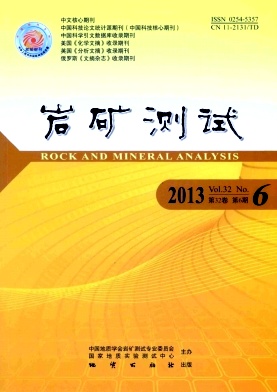Hui-ling YANG, Hui XIA, Tian-jun DU, Lu BAI, Jiu-hong QIN, Jin-lin TIE. Simultaneous Determination of Sn, W, Mo, Cu, Pb and Zn in Tin Ores by Inductively Coupled Plasma-Atomic Emission Spectrometry[J]. Rock and Mineral Analysis, 2013, 32(6): 887-892.
| Citation: |
Hui-ling YANG, Hui XIA, Tian-jun DU, Lu BAI, Jiu-hong QIN, Jin-lin TIE. Simultaneous Determination of Sn, W, Mo, Cu, Pb and Zn in Tin Ores by Inductively Coupled Plasma-Atomic Emission Spectrometry[J]. Rock and Mineral Analysis, 2013, 32(6): 887-892.
|
Simultaneous Determination of Sn, W, Mo, Cu, Pb and Zn in Tin Ores by Inductively Coupled Plasma-Atomic Emission Spectrometry
-
Hui-ling YANG1,2, ,
-
Hui XIA1,2, , ,
-
Tian-jun DU1,2,
-
Lu BAI1,2,
-
Jiu-hong QIN,
-
Jin-lin TIE1,2
-
1.
General Institute for Nonferrous Metals and Geological Exploration of Henan Province, Zhengzhou 450052, China
-
2.
Key Laboratory of Deep Ore-prospecting Technology Research for Non-ferrous Metals of Henan Province, Zhengzhou 450052, China
More Information
-
Corresponding author:
Hui XIA, xiahui_21@126.com
-
Abstract
The work involved to accurately determine the major and minor elements in tin ore, which contains large quantities of paragenetic and associated elements is extremely challenging. It is difficult to decomposed tin ore and the Sn, W and Mo are easily precipitated in HCl solution. A highly efficient analytic method which is capable of simultaneously determining Sn, W and Mo in tin ores by Inductively Coupled Plasma-Atomic Emission Spectrometry (ICP-AES) is reported in this paper. The ore samples are melted with Na2O2 and acidized by mixed tartaric acid, hydrochloric acid and hydrogen peroxide. Co is used as the internal standard element. The linear range of this present method is 0.00-40.0 mg/L, and the detection limits are 10 mg/kg for Sn, 30 mg/kg for W, 3.3 mg/kg for Mo, 12 mg/kg for Cu, 15 mg/kg for Pb and 40 mg/kg for Zn, respectively. The relative standard deviation (RSD,n=9) is less than 5.0%. All results of the National Standard Reference Materials determined by this method are consistent with the certified values. The samples can reach complete melting by using Na2O2 and the step to evaporate the HF acid to remove Si can be avoided, which results in reducing the processing time of samples. The application of mixed tartaric acid-hydrochloric acid-hydrogen peroxide system assists Sn, W and Mo to form stable complexations, which solves the problem of lower determining results due to forming precipitations of tungstenic acid, molybdic acid and stannic acid in HCl solution.
-

-
References
| [1] |
崔荣国,刘树臣,王淑玲,吴初国.我国重要优势矿产资源国际竞争力研究[J].中国矿业,2009,18(10): 8-11. doi: 10.3969/j.issn.1004-4051.2009.10.003
CrossRef Google Scholar
|
| [2] |
黄仲权.云南锡矿业现状及发展对策[J].矿产保护与利用,1992(6): 16-20.
Google Scholar
|
| [3] |
刘光亮,秦德先,张学书,范柱国.云南省锡矿资源与可持续发展[J].安全与环境工程,2004,11(4): 36-39.
Google Scholar
|
| [4] |
邵厥年,陶维屏.矿产资源工业要求手册[M].北京:地质出版社,2010:169-174.
Google Scholar
|
| [5] |
GB/T 1819-2004,锡精矿化学分析方法[S].
Google Scholar
|
| [6] |
GB/T 15924-1995,锡矿石化学分析方法[S].
Google Scholar
|
| [7] |
岩石矿物分析编委会.岩石矿物分析(第四版第三分册)[M].北京:地质出版社,2011: 185-208.
Google Scholar
|
| [8] |
岩石矿物分析编委会.岩石矿物分析(第四版第三分册)[M].北京:地质出版社,2011: 321-325.
Google Scholar
|
| [9] |
岩石矿物分析编委会.岩石矿物分析(第四版第三分册)[M].北京:地质出版社,2011: 338-342.
Google Scholar
|
| [10] |
赵建为,李树昌.辉钼矿中微量锡的分离与测定[J].岩矿测试,2000,19(3): 173-176.
Google Scholar
|
| [11] |
盛献臻,张汉萍,李展强,李海萍,何光涛.电感耦合等离子体发射光谱法同时测定地质样品中次量钨锡钼[J].岩矿测试,2010,29(4): 383-386.
Google Scholar
|
| [12] |
曾慧芳,戢朝玉,陈善科.ICP-AES法分析锡石单矿物的研究[J].岩矿测试,1988,7(3): 175-179.
Google Scholar
|
| [13] |
岩石矿物分析编委会.岩石矿物分析(第四版第三分册)[M].北京:地质出版社,2011: 297-299.
Google Scholar
|
| [14] |
张志龙.有色地质分析规程(下册)[M].北京:中国有色金属工业总公司地质局,1992:275-277.
Google Scholar
|
| [15] |
GB/T 14352.1-2010,钨矿石、钼矿石化学分析方法;钨量测定[S].
Google Scholar
|
| [16] |
GB/T 14352.2-2010,钨矿石、钼矿石化学分析方法;钼量测定[S].
Google Scholar
|
-
-
Access History







 DownLoad:
DownLoad: